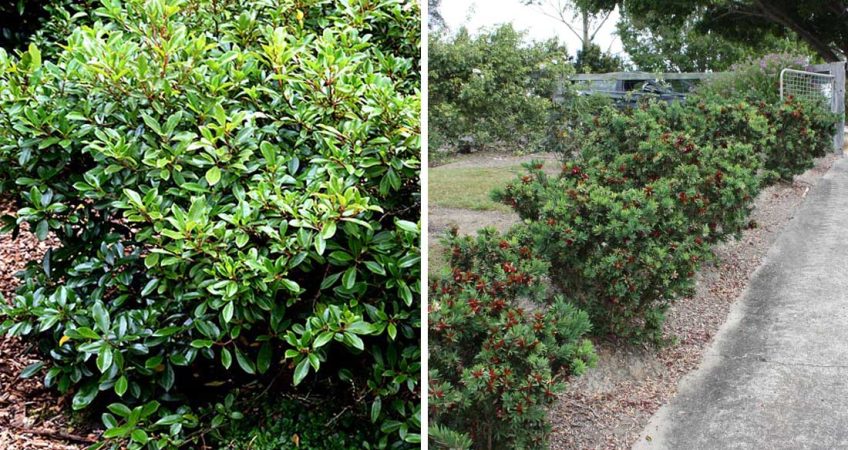Are you looking to add structure and beauty to your garden? Small hedges might be the perfect solution!
Small hedges not only add aesthetic appeal but also provide a practical function such as creating privacy or marking boundaries. They’re easy to maintain and can be used in a number of different ways.
Understanding Small Hedges: What Are They and Which Species to Choose?
Small hedges are typically compact shrubs that have a mature height shorter than 1.5 metres high, or can be maintained at a short height through pruning. They have dense foliage which makes them ideal for forming borders, edges, or barriers in a garden.
Small hedges can be evergreen or deciduous, and their leaves can vary widely in colour, shape, and texture. They aren’t as good for screening as taller hedges, except when the angle of visibility works, such as above a retaining wall or when hiding a small unsightly part of the garden.
- A wonderful Coprosma dodonaeifolia shrub in Auckland Botanic Gardens. You can regularly prune this plant for a tidier growth habit, or allow it to grow a bit wild for less maintenance. https://commons.wikimedia.org/wiki/File:Coprosma_dodonaeifolia_in_Auckland_Botanic_Gardens_02.jpg
Small hedges can be used to create ‘rooms’ or separate areas within a garden, line pathways, or frame features like statues or fountains. Their compact size makes them suitable for spaces with limited room.
They can also provide habitat for local wildlife, offering shelter and food sources for birds and insects.
Choosing the right hedge species and cultivar is crucial for the success of your garden design. The plant’s growth habit, hardiness, and care requirements should align with the conditions of your landscape and your ability to maintain the hedging plants.
Understanding the growth habit of a hedge species can help predict how it will behave in your garden. Some species may grow more vertically, creating a narrow, upright hedge, while others may spread outwards, forming a wider, lower hedge.
Hardiness refers to a plant’s ability to survive adverse growing conditions, such as cold temperatures or drought. Selecting hedge species that are hardy in your region’s climate will ensure their survival and growth.
The care needs of the hedge species, including water, sun, and soil preferences, as well as pruning requirements, should also be considered. It’s essential to choose a plant that will thrive in the space it’s given, ensuring a healthy and vibrant garden.
Top Small Hedge Varieties in New Zealand
Corokia spp.
Corokia is a genus of small shrubs that are native to New Zealand, making them an excellent choice for local gardens. These plants are known for their zig-zagging branches and small, dark green leaves. They produce star-shaped yellow flowers in the spring, followed by red or yellow berries.
Corokia species are remarkably hardy and can tolerate a variety of conditions, including coastal environments and frost. They prefer well-drained soil and full sun to partial shade. Regular pruning will maintain their dense, compact form, ideal for low hedges or borders.
Coprosma spp.
Coprosma, also known as mirror plants, are evergreen shrubs renowned for their glossy, colourful foliage. The leaves come in a range of colours, from vibrant greens to oranges, reds, and purples, adding interest to your garden year-round.
Coprosma species are very hardy, tolerating a range of soil types and conditions, though they prefer well-drained soil and a sunny position. They respond well to pruning, which can be done to maintain their shape and size as a hedge.
Pittosporum spp.
Pittosporum spp. are fast-growing New Zealand natives known for their beautiful, glossy green leaves and wavy leaf margins. They produce small, fragrant purple flowers in late spring and early summer. They make great tall hedges for screening.
These plants are highly adaptable, growing well in both sun and shade, and in a variety of soil types, though it prefers well-drained soil. They’re also drought-tolerant once established, making it a low-maintenance option for hedges. Frequent trimming will keep them small, dense and hedge-like.
Encore Azaleas
Encore Azaleas are a group of hybrid azaleas known for their ability to bloom more than once per year – in the spring, summer, and autumn. They’re compact shrubs with lush, green foliage and spectacular blooms in a range of colours, including white, pink, red, and purple.
Encore Azaleas are great hedges that prefer well-drained, slightly acidic soil and partial to full sun. Regular watering and fertilising will ensure healthy growth and abundant flowering. Explore Encore Azaleas.
Westringia hybrid ‘WES02’ PVR
This cultivar of Westringia that is ideal for creating compact hedges. It is a hardy plant, able to tolerate frost, drought, and coastal conditions.
It has beautiful grey-green foliage and delicate white flowers in spring. It prefers a sunny to partly shaded position and well-drained soil. Learn about Aussie Box Westringia.
Callistemon viminalis ‘LJ1’ PVR
This is a compact variety of Callistemon, also known as Bottlebrush, known for its bright red flower spikes and soft, blue-green foliage. It’s a hardy plant that can adapt to a range of soil types and conditions, including flooding and extended periods with wet feet.
It’s also drought-tolerant once established and requires minimal maintenance. Discover more about Better John Callistemon.
- Callistemon viminalis ‘LJ1’ PBR
Nandina domestica ‘AKA’ PVR
This is a variety of Nandina, also known as heavenly bamboo, celebrated for its unique pink foliage. This compact shrub holds onto its pink hue through the spring, summer, and autumn, before turning brilliant red in the winter.
It prefers well-drained soil and full sun to partial shade. Find out more about Blush Pink Nandina.
Raphiolepis indica ‘RAPH01’ PVR
This is a variety of Rhaphiolepis, also known as Indian Hawthorn, known for its large, white flowers and glossy green foliage.
It’s a frost hardy plant that can tolerate drought, making it another great low-maintenance hedge option. Explore Cosmic White Rhaphiolepis.
Viburnum odoratissimum
This is a variety of Viburnum, a fast-growing evergreen shrub with glossy green leaves which is perfect for creating a dense, tall hedge or screen.
It prefers well-drained soil and full sun to partial shade. Learn more about Dense Fence Viburnum.
Planting and Caring for Small Hedging Plants in New Zealand
1. Consider Spacing: The ideal spacing between your hedge plants depends on the specific variety, but as a general rule, smaller hedge plants can be planted around 30cm-40cm apart, while larger ones may need up to 1m of space. Take into account the mature width of plants, and install them a bit closer than that so that the branches meet and intertwine. Measure spacing, do some basic calculations, or simply place them on top of the ground in pots and make them look equally spaced to the naked eye.
2. Dig Holes: Each hole should be as deep as the root ball, and twice as wide.
3. Plant the Hedge: Place your plants in the holes, making sure that the top of the root ball is level with the ground. Backfill with soil, firming it gently around the base of the plants. Add compost or another type of organic fertiliser at this point.
4. Water Thoroughly: After planting, water the root zone thoroughly to settle the soil and help the plants establish.
5. Mulch: Covering bare soil with mulch helps protect the root zone from the sun, helps it retain moisture, and encourages healthy microbes to thrive.
Pruning and Maintenance for Hedge Plants
Maintaining your hedge involves regular pruning to keep it neat and healthy. Here’s how:
6. Prune Regularly: Most hedges benefit from being pruned at least once a year. The best time to do this is often in late winter or early spring, before the plants start to put on new growth. Faster-growing varieties need constant pruning throughout the warmer months to keep their shape.
7. Use Sharp, Clean Tools: Use a pair of sharp secateurs or a hedge trimmer to make clean cuts, which will help your plants recover more quickly. Clean and disinfect blades with soapy water, alcohol or a naked flame.
8. Trim to Shape: When pruning, aim to create a slightly tapered shape, with the base of the hedge wider than the top. This is best practice and helps to ensure that all parts of the hedge receive enough light.
9. Pruning Azaleas: Azaleas, however, should be pruned immediately after they finish flowering. This is because they produce their flower buds for the next year in the summer, so late pruning can remove these buds and reduce flowering. For the Encore Azala range, this would be in late autumn or very early in winter.
Small hedges are an invaluable addition to any garden or landscape design. Not only do they provide structure and year-round interest, and they can also offer food and habitat for wildlife.
Whether you’re an experienced gardener or a landscape architect, why not consider incorporating small hedges into your next project? With a wide range of species and cultivars available, there’s sure to be a small hedge that perfectly suits your needs.
FAQ
Do all small hedges have dark green foliage?
No, different hedge plants have different foliage colours. Plants can foliage ranging from dark green to light green, to yellow, orange, red and even shades of purple!
Do all plants need well drained soil?
No. While well-draining soil is often the optimal condition for many plants, there are many plants that do just fine with wet feet. Check out our studies on the best plants for wet conditions: https://www.ozbreed.com.au/category/plant-research/wet-feet-trials/

